Human immunodeficiency virus type 1 (HIV-1) subtype B epidemic in Panama is mainly driven by dissemination of country-specific clades
- PMID: 24748274
- PMCID: PMC3991702
- DOI: 10.1371/journal.pone.0095360
Human immunodeficiency virus type 1 (HIV-1) subtype B epidemic in Panama is mainly driven by dissemination of country-specific clades
Abstract
The Human immunodeficiency virus type-1 (HIV-1) subtype B is the most predominant clade in Central America; but information about the evolutionary history of this virus in this geographic region is scarce. In this study, we reconstructed the spatiotemporal and population dynamics of the HIV-1 subtype B epidemic in Panama. A total of 761 HIV-1 subtype B pol sequences obtained in Panama between 2004 and 2013 were combined with subtype B pol sequences from the Americas and Europe. Maximum Likelihood phylogenetic analyses revealed that HIV-1 subtype B infections in Panama derived from the dissemination of multiple founder viruses. Most Panamanian subtype B viruses (94.5%) belong to the pandemic viral strain proposed as originated in the US, whereas others (5.5%) were intermixed among non-pandemic Caribbean strains. The bulk (76.6%) of subtype B sequences from Panama grouped within 12 country-specific clades that were not detected in other Central American countries. Bayesian coalescent-based analyses suggest that most Panamanian clades probably originated between the early 1970s and the early 1980s. The root location of major Panamanian clades was traced to the most densely populated districts of Panama province. Major Panamanian clades appear to have experienced one or two periods of exponential growth of variable duration between the 1970s and the 2000s, with median growth rates from 0.2 to 0.4 year(-1). Thus, the HIV-1 subtype B epidemic in Panama is driven by the expansion of local viral strains that were introduced from the Caribbean and other American countries at an early stage of the AIDS pandemic.
Conflict of interest statement
Figures
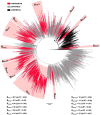
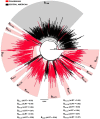
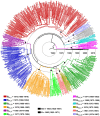
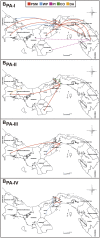
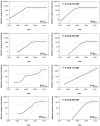
Similar articles
-
Spatiotemporal dynamics of dissemination of non-pandemic HIV-1 subtype B clades in the Caribbean region.PLoS One. 2014 Aug 22;9(8):e106045. doi: 10.1371/journal.pone.0106045. eCollection 2014. PLoS One. 2014. PMID: 25148215 Free PMC article.
-
Evolutionary history and spatiotemporal dynamics of the HIV-1 subtype B epidemic in Guatemala.PLoS One. 2018 Sep 13;13(9):e0203916. doi: 10.1371/journal.pone.0203916. eCollection 2018. PLoS One. 2018. PMID: 30212548 Free PMC article.
-
Dissemination of nonpandemic Caribbean HIV-1 subtype B clades in Latin America.AIDS. 2015 Feb 20;29(4):483-92. doi: 10.1097/QAD.0000000000000552. AIDS. 2015. PMID: 25630042
-
Molecular epidemiology of HIV-1 infection in Europe: An overview.Infect Genet Evol. 2016 Dec;46:180-189. doi: 10.1016/j.meegid.2016.06.033. Epub 2016 Jun 16. Infect Genet Evol. 2016. PMID: 27321440 Review.
-
Reviewing the history of HIV-1: spread of subtype B in the Americas.PLoS One. 2011;6(11):e27489. doi: 10.1371/journal.pone.0027489. Epub 2011 Nov 23. PLoS One. 2011. PMID: 22132104 Free PMC article. Review.
Cited by
-
The HIV-1 Subtype B Epidemic in French Guiana and Suriname Is Driven by Ongoing Transmissions of Pandemic and Non-pandemic Lineages.Front Microbiol. 2018 Jul 31;9:1738. doi: 10.3389/fmicb.2018.01738. eCollection 2018. Front Microbiol. 2018. PMID: 30108576 Free PMC article.
-
Spatiotemporal dynamics of dissemination of non-pandemic HIV-1 subtype B clades in the Caribbean region.PLoS One. 2014 Aug 22;9(8):e106045. doi: 10.1371/journal.pone.0106045. eCollection 2014. PLoS One. 2014. PMID: 25148215 Free PMC article.
-
Homogenous HIV-1 subtype B from the Brazilian Amazon with infrequent diverse BF1 recombinants, subtypes F1 and C among blood donors.PLoS One. 2019 Sep 9;14(9):e0221151. doi: 10.1371/journal.pone.0221151. eCollection 2019. PLoS One. 2019. PMID: 31498798 Free PMC article.
-
Bridging epidemiology with population genetics in a low incidence MSM-driven HIV-1 subtype B epidemic in Central Europe.BMC Infect Dis. 2015 Feb 15;15:65. doi: 10.1186/s12879-015-0802-6. BMC Infect Dis. 2015. PMID: 25887543 Free PMC article.
-
Phylogeographic Analyses Reveal the Early Expansion and Frequent Bidirectional Cross-Border Transmissions of Non-pandemic HIV-1 Subtype B Strains in Hispaniola.Front Microbiol. 2019 Jun 26;10:1340. doi: 10.3389/fmicb.2019.01340. eCollection 2019. Front Microbiol. 2019. PMID: 31333594 Free PMC article.
References
-
- Centers for Disease Control (CDC) (1981) Pneumocystis pneumonia–Los Angeles. MMWR Morb Mortal Wkly Rep 30: 250–252. - PubMed
-
- Centers for Disease Control (CDC) (1981) Kaposi’s sarcoma and Pneumocystis pneumonia among homosexual men–New York City and California. MMWR Morb Mortal Wkly Rep 30: 305–308. - PubMed
-
- UNAIDS (2013) Global Fact Sheet. Available: http://www.unaids.org/en/resources/. Accessed 2014 Mar 25.
-
- UNAIDS (2013) Global report. Report on the global AIDS epidemic. Available: http://www.unaids.org/en/media/unaids/contentassets/documents/epidemiolo.... Accessed 2014 Mar 25.
-
- Teva I, Bermudez MP, Ramiro MT, Buela-Casal G (2012) Current epidemiological situation of HIV/AIDS in Latin America: Analysis of differences among countries. Rev Med Chil 140: 50–58. - PubMed
Publication types
MeSH terms
LinkOut - more resources
Full Text Sources
Other Literature Sources
Medical
Molecular Biology Databases

